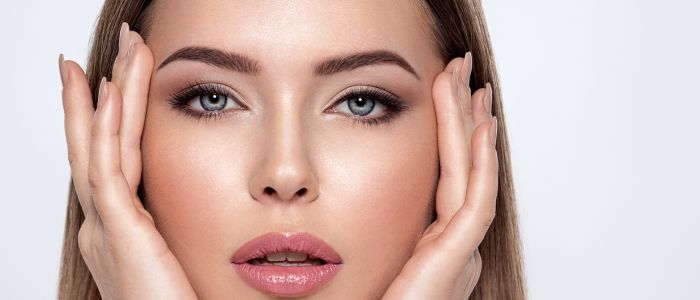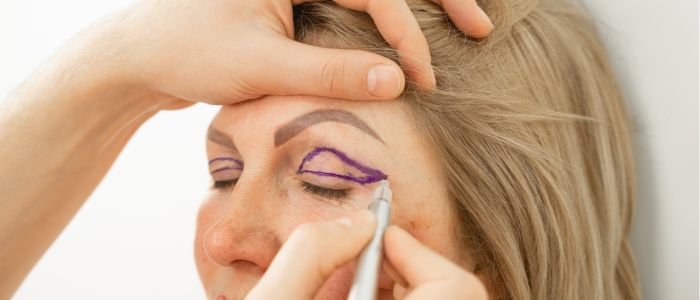
Table of Contents
- Eyelid Surgery – Blepharoplasty – Reasons, Types and Costs
- Reasons for Considering Eyelid Surgery
- Types of Eyelid Surgery
- The Eyelid Surgery Procedure Explained
- Risks and Complications
- Combining Eyelid Surgery with Other Procedures
- Cost and Financing Options
- Non-Surgical Alternatives to Eyelid Surgery
- Cosmetic Injections
- Laser Treatments
- Radiofrequency and Ultrasound Treatments
- Microneedling
- FAQs about Eyelid Surgery
- Further Reading about Eyelid Surgery with Consultant Plastic Surgeon Anca Breahna
Eyelid Surgery – Blepharoplasty – Reasons, Types and Costs
Eyelid surgery might involve removing excess skin, muscle, and occasionally fat to amend the appearance of the eyelids. The surgery can be conducted on the upper lids, lower lids, or both. This procedure is not only sought after for aesthetic reasons but is also performed to address functional problems that can impair vision.
Patients opt for this surgery for numerous reasons. From an aesthetic viewpoint, the surgery can significantly alter the appearance of the face, giving the eyes a more open and rested look. From a functional perspective, excess skin on the upper eyelids can sag and hinder vision, making daily activities like driving and reading increasingly difficult. In such cases, eyelid surgery offers a practical solution to improve the field of vision.
Selecting to undergo eyelid surgery is a significant decision and necessitates a thorough understanding of the procedure, including what it entails, the recovery process, and realistic outcomes. It is also vital to be aware of any potential risks and to have clear communication with Consultant Plastic Surgeon Anca Breahna about expectations and results.
Reasons for Considering Eyelid Surgery
You might contemplate eyelid surgery for a variety of reasons, spanning from aesthetic alterations to addressing medical issues:
- Aesthetic Enhancements: Many people opt for eyelid surgery to refine the appearance of their eyes and face. Over time, the skin around the eyes can lose elasticity, leading to drooping eyelids, bags under the eyes, and a tired or aged appearance. Eyelid surgery can address these issues by removing excess skin and fat, resulting in a more rested and pleasing appearance. This procedure can also make the eyes appear larger and more vibrant, enhancing the overall facial aesthetics.
- Medical Necessities: Beyond cosmetic reasons, eyelid surgery is often pursued for medical benefits. Excess skin on the upper eyelids can droop severely, impairing one’s vision by obstructing the field of view. This condition can make everyday tasks like reading, driving, and using a computer challenging and unsafe. By removing the obstructive skin, eyelid surgery can improve vision and, consequently, the quality of one’s daily life.
- Improved Vision: For some, the primary incentive for undergoing eyelid surgery is the improvement of peripheral vision. Sagging eyelids can significantly reduce your visual range, affecting both safety and functionality. After the surgery, many patients report a notable improvement in their field of vision, which can enhance their ability to participate in activities like driving, reading, and engaging in various sports or hobbies.
Types of Eyelid Surgery
The three primary types of eyelid surgery are upper eyelid surgery, lower eyelid surgery, and double eyelid surgery.
- Upper Eyelid Surgery focuses on correcting issues in the upper eyelid. It’s often chosen by people who have excess skin obscuring their natural eyelid crease, which can also impede their vision. During this procedure, Anca makes a careful incision along the eyelid’s crease to remove surplus skin, muscle, and sometimes fat. The goal is to create a more open, alert appearance of the eyes, while also potentially improving your field of vision.
- Lower Eyelid Surgery is primarily aimed at improving the appearance of the lower eyelids. This procedure is suitable for those who have puffiness or ‘bags’ under their eyes, which are usually caused by the accumulation of fat. An incision is made just below the lashes or inside the eyelid, allowing Anca to remove or redistribute excess fat, and in some cases, remove excess skin or tighten the muscles.
- Double Eyelid Surgery, also known as Asian eyelid surgery, is designed to create a crease in the eyelid that is not naturally present. This procedure is particularly popular in East Asia and among individuals of Asian descent who wish to have a more defined eyelid crease. The surgery can be customised to create a natural-looking crease that complements your facial features.
Choosing the right type of eyelid surgery requires careful consideration and discussions with Anca. During the consultation, Anca will examine your eyelids, discuss your aesthetic and functional goals, and recommend the most appropriate procedure. It is essential to have realistic expectations and to understand the potential outcomes of the chosen surgery.
The Eyelid Surgery Procedure Explained
The specific techniques and steps involved vary depending on the type of eyelid surgery being performed—upper, lower, or both. However, the goal remains the same.
Eyelid surgery typically begins with the administration of anaesthesia to ensure comfort throughout the procedure. The type of anaesthesia used can vary from local, which numbs only the area around the eyes, to general, which renders you unconscious for the duration of the surgery.
For upper eyelid surgery, an incision is made along the fold of the eyelid, allowing Anca to remove or reposition fat deposits, tighten muscles, and remove excess skin. The incision lines are carefully planned to ensure they are well-concealed within the natural structures of the eyelid region.
In lower eyelid surgery, the incision is usually made just below the lash line or inside the lower eyelid. This approach allows Anca to remove excess skin, eliminate or redistribute fat, and improve the contour of the eyelid, addressing bags under the eyes and correcting droopiness.
Safety is of paramount importance in any surgical procedure. The choice between local and general anaesthesia will be based on the complexity of the surgery and your overall health. The surgical team closely monitors your vital signs throughout the procedure to ensure the utmost safety.
The duration of eyelid surgery can vary but lasts from one to three hours, depending on whether both upper and lower eyelids are being addressed. Eyelid surgery is generally performed as an outpatient procedure, meaning you can go home the same day, under the care of a responsible adult.
Risks and Complications
Although eyelid surgery is generally safe, some common risks include infection, bleeding, scarring, and reaction to anaesthesia. Swelling and bruising are typical after the surgery, but in rare cases, excessive swelling can lead to complications.
One of the specific risks associated with eyelid surgery is temporary blurred or impaired vision. Most patients experience this only briefly, but it’s crucial to monitor the situation and report any prolonged or severe symptoms to your surgeon immediately.
Dry eyes are another common side effect that can result from eyelid surgery. In most instances, this condition is temporary and can be managed with lubricating eye drops. However, if the problem persists, further treatment may be necessary.
Combining Eyelid Surgery with Other Procedures
Combining eyelid surgery with other facial procedures is a common practice that can enhance the overall rejuvenation effects and lead to more harmonious results. When eyelid surgery is performed in conjunction with other treatments, patients can achieve a more comprehensive improvement in their appearance.
Common Complementary Procedures
- Facelift: A facelift targets the lower two-thirds of the face and can be an excellent complement to eyelid surgery, especially for patients looking to address sagging skin and deep wrinkles around the mouth and jawline.
- Brow Lift: A brow lift raises the eyebrows and reduces wrinkles on the forehead and between the eyes, complementing the effects of upper eyelid surgery by enhancing the upper face’s overall youthful appearance.
- Laser Resurfacing: This procedure can improve skin texture, tone, and fine lines. When combined with eyelid surgery, it can enhance the skin’s appearance around the eyes for a more refreshed look.
Considerations and Recommendations
- Health and Safety: Your overall health and safety are the primary considerations when planning multiple procedures. Anca will evaluate whether you are a suitable candidate for combined surgery based on your medical history, current health status, and the specific procedures being considered.
- Recovery: It’s important to understand that combining procedures may extend the recovery time. You should be prepared for a more comprehensive post-operative care plan and potentially a longer period of downtime.
- Expectations: Clear communication with Anca about the desired outcomes and realistic expectations is essential. A thorough consultation will help ensure that the combined procedures align with your goals and expectations.
If you are considering combining eyelid surgery with other facial procedures, you should discuss your options with Anca. This collaborative approach will help tailor the surgical plan to meet your aesthetic goals while ensuring safety and the highest quality of care.
Cost and Financing Options
The total cost typically includes your surgeon’s fee, anaesthesia fee, facility fee, and any additional costs such as pre-operative tests and post-operative care supplies. It’s important to obtain a detailed quote during your consultation to understand what is included in the cost and to plan accordingly.
The cost of eyelid surgery can also differ depending on whether you’re having upper eyelid surgery, lower eyelid surgery, or both. Additionally, if eyelid surgery is being combined with other facial procedures, the overall cost will be higher, but package deals may also offer value.
Insurance Coverage and Exceptions: In cases where eyelid surgery is performed for cosmetic reasons, it is unlikely that the procedure will be covered by health insurance. However, if the surgery is deemed medically necessary — for example, if drooping eyelids are significantly impairing your vision — some or all of the cost may be covered by your insurance policy.
Documentation from your surgeon, including notes on how the eyelid issue affects your vision and quality of life, can support your claim for insurance coverage. Visual field tests and photographs may also be required to demonstrate the necessity of the procedure.
Non-Surgical Alternatives to Eyelid Surgery
While eyelid surgery offers long-lasting and significant improvements for those looking to alter the appearance of their eyelids or address functional issues, some people may seek non-surgical alternatives for various reasons. These alternatives can offer less invasive options for rejuvenating the eye area without the downtime associated with surgery. Here, we explore several popular non-surgical treatments that can help refresh and enhance the eye area:
Cosmetic Injections
- Neuromodulator Injections: These injections can temporarily relax the muscles around the eyes, reducing the appearance of crow’s feet and fine lines. They can also be used to slightly lift the eyebrows, offering a subtle lift to the upper eyelids.
- Dermal Fillers: Fillers can be used to add volume to hollow areas under the eyes, reducing the appearance of under-eye bags and dark circles. They can also smooth out wrinkles and fine lines around the eyes.
Laser Treatments
- Laser Skin Resurfacing: This technique uses focused light to remove the outer layer of skin, stimulating collagen production and leading to smoother, tighter skin around the eyes. It can address fine lines, wrinkles, and uneven skin tone.
- Intense Pulsed Light (IPL): IPL treatments can reduce the appearance of dark circles under the eyes by targeting and reducing pigmentation and improving skin texture.
Radiofrequency and Ultrasound Treatments
- Thermage and Ultherapy: These treatments use radiofrequency and ultrasound energy, respectively, to heat the deep layers of the skin, encouraging the production of new collagen. The result is tighter, more lifted skin around the eyes, with reduced sagging and wrinkling.
Microneedling
- Microneedling with PRP (Platelet-Rich Plasma): This procedure involves creating tiny punctures in the skin with fine needles and applying PRP, derived from the patient’s own blood, to promote healing and rejuvenation. It can improve skin texture and elasticity around the eyes.
Non-surgical treatments typically involve less downtime and lower risk than surgical options. However, their results are usually temporary and may require regular maintenance sessions. It’s also important to note that while these treatments can offer significant improvements, they may not be able to achieve the same level of correction as surgical eyelid procedures, particularly for patients with substantial excess skin or fat around the eyes.
FAQs about Eyelid Surgery

How long does the actual eyelid surgery procedure take?
Typically, eyelid surgery can take between one to three hours, depending on whether you’re having surgery on the upper eyelids, lower eyelids, or both. The duration may also vary if eyelid surgery is combined with other facial procedures.
Can eyelid surgery correct vision problems?
While eyelid surgery itself does not directly correct vision problems like near-sightedness or farsightedness, it can improve peripheral vision significantly for patients whose sagging upper eyelids obstruct their field of view. This procedure is primarily aimed at removing the excess skin that causes the visual impairment.
Will there be visible scars after eyelid surgery?
Eyelid surgery incisions are strategically placed in the natural creases of the eyelids or inside the lower eyelid, making scars well-concealed once they have healed properly. Over time, these scars typically become barely noticeable.
Is there an ideal age for undergoing eyelid surgery?
There is no “ideal” age for eyelid surgery. Candidates for this procedure range from their 30s to older ages. The timing often depends on your specific concerns, skin condition, and whether the eyelid issues are affecting the quality of life or vision.
How long will the results of eyelid surgery last?
The results of eyelid surgery are long-lasting. While the procedure can’t halt the aging process, improvements, particularly in removing excess skin and fat, can be significant and enduring. Many patients find that the results last for many years, and for some, the results are effectively permanent.
Medical References about Eyelid Surgery
Further Reading about Eyelid Surgery with Consultant Plastic Surgeon Anca Breahna
- Read more about What Are Hooded Eyelids?
- Read more about Solutions for Saggy Eyelids
- Read more about When Can I Exercise after Eyelid Surgery
- Read more about How to Avoid Blepharoplasty Complications
- Read more about Recovery after Eyelid Surgery
- Read more about Options for Eye Bag Surgery
- Read more about What Can Be Done to Reduce Eyelid Surgery Scars?
- Read more about Recovery after Eyelid Surgery
- Read more about Causes and Treatments for Facial Wrinkles and Lines
- Read more about Eyelid Surgery in Your 30s, 40s, 50s And 60s
- Read more about Treatment and Solutions for Droopy Eyelids
- Read more about Can Eye Bags Go Away?
- Read more about Eyelid Surgery FAQs
- Read more about Preserving Eyelid Function: Techniques for Successful Blepharoplasty








